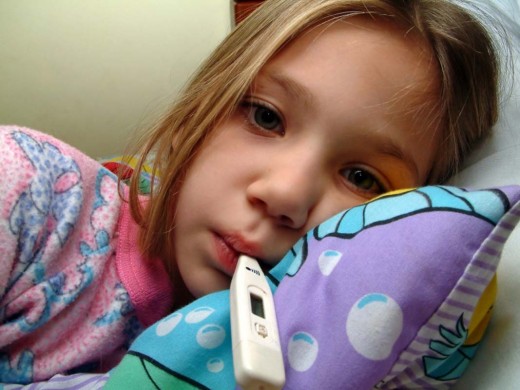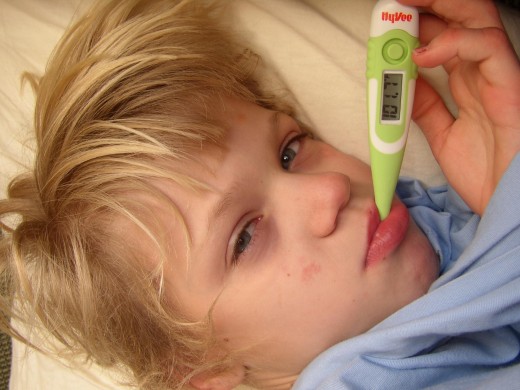Fever: Health Relevance Of Its Diagnosis And Clinical management To Man
High Temperature In A Toddler

Diagnosis Of Infections With Fevers
History should include the details of the place of residence, recent visit to endemic areas, the pattern of onset and course of fever, and the accompanying clinical phenomena.
General examination is very important. Jaundice, cyanosis, coating of the tongue with the pattern of coating, generalized lymphadenopathy, clubbing, arthritis, lymphangitis or swelling of one or more legs, splinter hemorrhages in nails, and tenderness over sinuses should be looked for. Special care should be taken to detect rashes, eruptions or eschar. If rashes are present, the day of their appearance, the type and distribution should be noted. The eruptions may be macular, popular, maculopapular, vesicular, pustular or hemorrhagic. Examination of the mouth for evidence of Koplik’s spots which is an early sign of measles is important. Elicitation of neck rigidity, Kernig’s sign, evidence of any middle ear discharge and mastoid tenderness are of great help to diagnose meningitis early.
The pulse should be counted for one minute and recorded. Relative bradycardhia is characteristic of typhoid, meningitis and many viral infections (slow pulse fevers), while relative tachycardia is seen in rheumatic fever, tuberculosis and pneumonia (rapid pulse fevers). The Heart should be examined for the presence of abnormalities which, if present, suggest the possibility of infective endocarditis. Pericardial effusion should be ruled out by physical examination.
Since respiratory infections account for many of the fevers, the respiratory system should be examined with a view to detect infections such as bronchitis, pneumonia, tuberculosis, bronchiectasis, lung abscess and pleural effusion. Careful examination of the abdomen may reveal hepatosplenomegaly (increase in size of the liver and spleen) and gurgling in the right iliac fossa which is a common sign in enteric fevers. Pelvic structures should be examined in females. Examination of internal genitalia is essential to rule out infections and malignancies.
Record of all the findings should be made periodically since additional findings might appear in the course of the illness and this may be helpful in the final diagnosis. The clinical examination should be followed up by investigations. A general pattern of investigations may be adopted for all fevers. In addition, special investigations have to be carried out as and when necessary.
Using Fever Variant To Diagnose Patients

General Management Of Fevers
The patient should be put to bed. Adequate nourishment and fluid and electrolytes should be provided during the acute phase. Since fever accelerates metabolism leading to breakdown of tissues, metabolism leading to breakdown of tissues, 2000 to 25000 Cal should be provided in the form of palatable, easily digestible food. The fluid intake should be 2 to 3 liters a day.
In uncomplicated cases, it is not necessary to bring down the temperature by antipyretics. If it rises above 400C, physical measures like sponging with tepid water and exposure of the body to an air current should be done to arrest further rise. Cold compresses over the body and ice cap over the forehead also serves to dissipate heat and give relief. Antipyretics like aspirin 0.3 to 0.6 g or paracetamol, 0.5g promptly bring down the temperature for 4 to 6 hours in most cases. These drugs may have to be repeated at 6 hours intervals. Large doses of antipyretics may bring about a crisis.
During fevers, there is a general tendency to develop constipation. This can be reduced by giving adequate food and fluids. If constipation is troublesome, bowels may be opened by a glycerine suppository or a small enema. Dehydration results in oliguria and the highly concentrated urine causes dysuria, even retention. Adequate fluid intake is necessary to maintain normal urine volume. Simple measures like keeping a hot water bag over the lower abdomen or an enema may help to void urine. Catheterisation of the bladder should be avoided as far as possible.
In prolonged illnesses such as enteric fever, or rheumatic fever, proper positioning in bed and care of the skin to avoid bed sores are essential. Dryness of the mouth and presence of food particles cause infection of the mouth, gums and parotid glands. Proper oral hygiene and frequent sips of fluids serve to prevent thess complications. When specific etiological diagnosis is made, appropriate treatment should be started without delay. In most of the cases, this measure brings about dramatic relief of the symptoms.
© 2014 Funom Theophilus Makama









